Презентация на тему: Английский язык: межкультурная коммуникация




Module 1 Module 1 Module 2 Module 3


Historically, the word derives from the Latin word Historically, the word derives from the Latin word ‘colere’, which could be translated as ‘to build’, ‘to care for’, ‘to plant’ or ‘to cultivate’. Spencer-Oatey (2000) proposed the following definition: Culture is a fuzzy set of attitudes, beliefs, behavioural norms, and basic assumptions and values that are shared by a group of people, and that influence each member's behaviour and his/her interpretations of the "meaning" of other people's behaviour. Hall (1983) views culture as often subconscious: “Culture has always dictated where to draw the line separating one thing from another. In the West a line is drawn between normal sex and rape, whereas in the Arab world is much more difficult, for a variety of reasons, to separate these two events.”

Hofstede (1994) defined Hofstede (1994) defined culture as “the collective programming of the mind which distinguishes the member of one group or category of people from another” Kroeber & Kluckhohn definition of culture reads ‘Culture consists of patterns, explicit and implicit, of and for behaviour acquired and transmitted by symbols, constituting the distinctive achievements of human groups, including their embodiment in artifacts; …’ the essential core of culture consists of traditional (i.e. historically derived and selected) ideas and especially their attached values; culture systems.

Quotations Quotations O Mankind, We created you from a single (pair) of a male and a female and made you into nations and tribes, that you may know each other. The Quran, 49:13 Culture is a thin but very important veneer that you must be careful not to scratch. People from different cultures are basically the same and respond in the same way. However, make sure that you understand their basic customs and show an interest and willingness to learn the differences between your cultures. Mike Wills Culture is the way in which a group of people solves problems and reconciles dilemmas. E. Schein Culture is the fabric of meaning in terms of which human beings interpret their experience and guide their action. Clifford Geertz

Quotations Quotations I do not want my house to be walled in on all sides and my windows to be stuffed. I want the cultures of all the lands to be blown about my house as freely as possible. But I refuse to be blown off my feet by any. Mahatma Gandhi Culture is a little like dropping an Alka-Seltzer into a glass-you don't see it, but somehow it does something. Hans Magnus Enzensberger If man is to survive, he will have learned to take a delight in the essential differences between men and between cultures. He will learn that differences in ideas and attitudes are a delight, part of life's exciting variety, not something to fear. Gene Roddenberry On a group of theories one can found a school; but on a group of values one can found a culture, a civilization, a new way of living together among men. Ignazio Silone

Quotations Quotations A culture may be conceived as a network of beliefs and purposes in which any string in the net pulls and is pulled by the others, thus perpetually changing the configuration of the whole. Jacques Barzun Culture is the name for what people are interested in, their thoughts, their models, the books they read and the speeches they hear, their table-talk, gossip, controversies, historical sense and scientific training, the values they appreciate, the quality of life they admire. All communities have a culture. It is the climate of their civilization. Walter Lippmann Culture means control over nature. Johan Huizinga Culture is roughly anything we do and the monkeys don't. Lord Raglan

● CORPORATE CULTURE (for example, the culture of Microsoft) ● CORPORATE CULTURE (for example, the culture of Microsoft) ● PROFESSIONAL CULTURE (for example, the culture of lawyers or doctors) ● GENDER CULTURE (for example, the different cultures of men and women) ● AGE CULTURE (for example, the culture of young, middle-aged, and old people) ● RELIGIOUS CULTURE (for example, Catholicsm, Islam) ● REGIONAL CULTURE (for example, Northern and Southern Italy) ● CLASS CULTURE (for example, working class, middle class, and upper class) factors that bind people together

intracultural The term intracultural is used to describe data and interactional data from within one cultural group. intracultural The term intracultural is used to describe data and interactional data from within one cultural group. For example: Value variations among Germans is intracultural. intercultural The term intercultural is generally used to describe comparative data and studies of a large number of cultures, or studies that try to identify dimensions that are not culture specific. For example: Hofstede's work is intercultural, as it desribes cultural dimensions applicable for all cultures. Intercultural is also used to describe interactional data from members of different cultural backgrounds (normally more than two).



CULTURAL DIMENSIONS CULTURAL DIMENSIONS Non-verbal communication Communication style Time and space Power The individual and the group Uncertainty Nature

Geert Hofstede, the Dutch social psychologist and engineer, collected data from employees of IBM in the late 1960s and early 1970s. Geert Hofstede, the Dutch social psychologist and engineer, collected data from employees of IBM in the late 1960s and early 1970s. His database cover­ed employees working in 72 of the company's national subsidiaries, who fol­lowed 38 different occupations, and spoke 20 languages. More than 116,000 questionnaires were distributed, each with over 100 questions. Hofstede published his findings in 1980 in a groundbreaking book called Culture's Consequences, which has had an enormous influence on the further develop­ment of the field.

He identified four dimensions: He identified four dimensions: individualism/collectivism uncertainty avoidance power distance masculinity/femininity Hofstede later extended his work to include a fifth dimension: LONG-TERM ORIENTATION . Although generally highly respected, his work has been criti­cized for concentrating too much on national cultures.

Individualist cultures stress self-realization, whereas collectivist ones require that the individual fits into the group. Individualist cultures stress self-realization, whereas collectivist ones require that the individual fits into the group. The collectivist idea is illustrated by the Japanese saying 'The nail that stands out must be hammered down'. In indi­vidualist cultures, people look after themselves and their immediate family, whereas in collectivist ones they look after a wider group, in exchange for loyalty.

Collectivist cultures tend to have the following features: identity is based on the social network to which you belong harmony should be maintained communication is high context employer—employee relationships are like a family link decisions on employing people take the group into account management is management of groups relationship is more important than task. (Adapted from Hofstede 1991:67)

Individualist cultures stress self-realization, whereas collectivist ones require that the individual fits into the group. Individualist cultures stress self-realization, whereas collectivist ones require that the individual fits into the group. The collectivist idea is illustrated by the Japanese saying 'The nail that stands out must be hammered down'. In individualist cultures, people look after themselves and their immediate family, hereas in collectivist ones they look after a wider group, in exchange for loyalty.

Individualist cultures tend to have the following features: Individualist cultures tend to have the following features: identity is based on the individual honest people speak their mind communication is low context employer-employee relationships are based on a contract decisions to employ people take skills into account management is management of individuals task is more important than relationship. (Adapted from Hofstede 1991:67)


China – 80 India – 77 Iran – 58 Russia – 93 Saudi Arabia – 80 Turkey – 66 Egypt – 80 Germany - 35

Individualism is one of the five intercultural dimensions developed by Hofstede. This cultural dimension looks at how much a culture emphasises the rights of the individual versus those of the group (whether it be family, tribe, company, etc). Individualism is one of the five intercultural dimensions developed by Hofstede. This cultural dimension looks at how much a culture emphasises the rights of the individual versus those of the group (whether it be family, tribe, company, etc). Individualist cultures include the United States and much of Western Europe, where personal achievements aremphasised. Collectivist cultures, such as China, Korea, and Japan, emphasize the group such as the family and at work this manifests in a strong work group mentality.

Masculinity is one of the five intercultural dimensions developed by Hofstede. It is also one of the least understood as many people tend to associate it with masculinity literally. In essence it looks at the degree to which 'masculine' values like competitiveness and the acquisition of wealth are valued over 'feminine' values like relationship building and quality of life.

From Hofstede's research Japan was found to From Hofstede's research Japan was found to be the world's most masculine society, with a rating of 95. Sweden was the most feminine with a rating of 5. Other examples of "masculine" cultures include the USA, the Germany, Ireland and Italy. "Feminine" cultures include Spain, Thailand, Korea, Portugal and the Middle East.


China – 30 China – 30 India – 40 Iran – 58 Russia – 95 Saudi Arabia – 68 Turkey – 85 Egypt – 68 Germany - 65

PDI (Power Distance Index) - the degree of equality or inequality between people in a country's society. PDI (Power Distance Index) - the degree of equality or inequality between people in a country's society. IDV (Individualism) - the degree to which a culture values and reinforces the importance of the individual as opposed to the group. MAS (Masculinity) - the degree to which a culture reinforces the traditional role of males vs females. VAI (Uncertainty Avoidance) - the level of tolerance for uncertainty and ambiguity within a culture.

Dutchman, Fons Trompenaars, carried out research on Dutchman, Fons Trompenaars, carried out research on 15,000 managers from 28 countries. His findings can be found in the Very successful book, Riding the Waves of Culture (Trompenaars and Hampden-Turner 1997). He describes three main cultural dimensions: RELATIONSHIPS WITH PEOPLE ATTITUDE TO TIME ATTITUDE TO THE ENVIRONMENT

The fundamental acceptance of people who are different to oneself outside one's own culture. The fundamental acceptance of people who are different to oneself outside one's own culture. The ability to interact with them in a genuinely constructive manner which is free of negative attitude (e.g. prejudice, defensiveness, apathy, aggression etc.) The ability to create a synthesis, something which is neither "mine" nor "yours", but which is genuinely new and would not have been possible had we not combined our different backgrounds and approaches.

Self-Awareness: People learn about their own strengths, weaknesses, prejudices and preconceptions. Self-Awareness: People learn about their own strengths, weaknesses, prejudices and preconceptions. Builds Confidence: Cultural competency training promotes self-confidence in individuals and teams through empowerment. Breaks down Barriers: Our cultural training demystifies 'the other' and creates awareness. Builds Trust: Awareness leads to dialogue which leads to understanding which results in trust. Motivates: Through self-analysis people begin to recognise areas in which they need to improve and become motivated to develop.

Opens Horizons: Cultural competency training helps people think outside the box. Opens Horizons: Cultural competency training helps people think outside the box. Develops Skills: Participants develop better 'people skills' - they begin to deal with people with sensitivity and empathy. Develops Listening Skills: By becoming good listeners, people become good communicators. Using Common Ground: Rather than focus on differences participants move towards creating a shared space. Career Development: Cross cultural competence training enhances people's skills and therefore future employment opportunities.

Simply stated, an interculturally effective person is omeone Simply stated, an interculturally effective person is omeone who is able to live contentedly and work successfully in another culture. Taken a little further, the interculturally effective person has three main attributes: an ability to communicate with people of another culture in a way that earns their respect and trust the capacity to adapt his/her professional skills (both technical and managerial) to fit local conditions and constraints the capacity to adjust personally so that s/he is content and generally at ease in the host culture

1. Break Assumptions 1. Break Assumptions Assumptions are beliefs rather than objective truth and are usually influenced by a number of subjective factors. 2. Empathise Through putting yourself in someone else's shoes you come to see or appreciate their oint of view. 3. Involve Involving others in tasks or decision making empowers and builds strong relationships, a more creative approach to problem solving as it incorporates different points of view.

4. Discourage Herd Mentality 4. Discourage Herd Mentality It encourages creativity, innovation and advancement 5. Shun Insensitive Behaviour By attacking someone's person, you attack their culture and therefore their dignity. This can only be divisive. 6. Be Wise Intercultural communication is essentially founded upon wisdom, i.e. showing maturity of thought and action in dealing with people.

The widely known work of Milton Bennett helps to elucidate the process The widely known work of Milton Bennett helps to elucidate the process of adaptation to a new culture. In his work, Developmental Model of Intercultural Sensitivity, 1993, he describes six main stages in the development of intercultural sensitivity: denial defensiveness minimization acceptance adaptation integration

The symptoms of culture shock can include: The symptoms of culture shock can include: strain sense of loss anxiety helplessness Physical symptoms can include: headaches sleeplessness desire for comfort foods (for example, chocolate) excessive consumption of alcohol


There are several stages most newcomers go through in adjusting to a new culture. 1. Fun: The excitement and adventure of experiencing new people, things, and opportunities. 2. Flight: The urge to avoid everything and everyone that is different. This stage is characterized by symptoms similar to those seen in cases of clinical depression, but as a reaction to culture shock.

There are several stages most newcomers go through in adjusting to a new culture. 3. Fight: The temptation to judge people or things that may be different in a negative light. At this stage, one wrestles with the influence of the new culture while resisting giving up one's original cultural identity. Hopefully, a blend will emerge that fits you well. 4. Fit: Willingness to understand, to embrace, and to creatively interact with the new culture. At this final stage, adaptation to the local culture has been made and hopefully one has made a decent adjustment.


Fast Messages Fast Messages Prose Headlines A communiqué Propaganda Cartoons TV commercials Television Easy familiarity Manners


do one thing at a time do one thing at a time concentrate on the job take time commitments (deadlines,schedules) seriously are low-context and need information are committed to the job adhere religiously to plans are concerned about not disturbing others; follow rules of privacy and consideration show great respect for private property; seldom borrow or lend emphasize promptness are accustomed to short-term relationships


Time and Its Control --------- Human Interaction Time and Its Control --------- Human Interaction (punctuality, keeping schedules) (relations between people most important) Personal Control over ---------- Fate the Environment (course of events is beyond power or (Each person should control control) is beyond power whatever might affect him) Self-Help ---------- Birthright Inheritance (a person's achievement (privilege of birth; inherited on his own) wealth or social position)

Change ------------------ Tradition Change ------------------ Tradition (connotes improvement, (honours rich and ancient development, growth and heritage/ civilization) progress) Future Orientation ------------------- Past orientation (looking to future as better, (past kept alive, today’s planning and goal setting) world seen as continuity of past) Individualism/Privacy ------------------- Group’s welfare Competition ------------------- Cooperation

Equality --------------- Hierarchy/Rank/System Equality --------------- Hierarchy/Rank/System (position in society clearly define by rank/status) Informality -------------- Formality Practicality/Efficiency -------------- Idealism (philosophical, knowledge for knowledge’s sake) Directness/Openness/ Honesty --------------- Indirectness/Ritual/”Face” Action/Work Orientation --------------- “Being” Orientation (action is superior to inaction) (state of inaction is acceptable, concern with the nature of existence and inner self) Materialism/Acquisitiveness -------------- Spiritualism/Detachment

Trompenaars and Hampden-Turner in their book “Riding The Waves of Culture” (1997), identify seven value orientations. Some of these value orientations can be regarded as nearly identical to Hofstede’s dimensions. Others offer a somewhat different perspective.

Universalism versus Particularism Communitarianism versus Individualism Neutral versus Emotional Defuse versus Specific cultures Achievement versus Ascription Human-Time relationship and Human-Nature relationship



eye behaviour (occulesics) facial expressions posture limb movements (kinesics) tone and pitch of voice (paralanguage) distance (proxemics)


body movement, body position and facial expressions, as well as dress


It is not only words used that convey a message, but also It is not only words used that convey a message, but also range of other factors, such as our tone of voice, and the speed or pitch of what we say. Intonation patterns and tone of voice vary widely in different cultures. What in one culture sounds like a hysterical argument, in another would be con­sidered to be the norm for a reasonable discussion. Geoff Woodside came to the wrong conclusion about the tone ofthe conversation when he judged the sound of people speaking in Polish by the Very different intonation patterns in English.

Trompenaars provides a useful diagram to illustrate some possible patterns.


High-context culture establish relationship first value personal relations and goodwill agreement based on trust slow and ritualistic negotiations

Making small talk Making small talk Specific Diffuse Attitudes to time Monochronic Synchronic Team-working Individualist Collectivist Questioning style Direct Indirect

How much detail? Low context High context Attitudes to risk High uncertainty avoidance Low uncertainty avoidance Showing respect Achievement Status

China - the family name only for business purposes - the surname, together with a title China - the family name only for business purposes - the surname, together with a title India - the appropriate formal title Italy - wait until invited to move to a first name basis Spain - the basic titles of courtesy followed by the surname Sweden - his/her first name Japan - first names are usually reserved for family and close friends even if you are on a first name basis, it is appropriate to use his or her last name in the presence of colleagues use courtesy titles in addition to last names use professional titles in the place of actual names

Germany - firm, brief handshakes - avoid shaking hands with one hand in your pocket Italy - an enthusiastic handshake yet rather formal with direct eye contact and a smile suffices between strangers - air-kissing on both cheeks, starting with the left is often added as well as a pat on the back between men once a relationship develops

India - a handshake India - a handshake the namaste - the palms are brought together at chest level with a slight bow of the head Russia - a (very) firm handshake Turkey - shake hands firmly - greet friends and relations with either one or two kisses on the cheek - respect elders by kissing their right hand then placing the forehead onto the hand

Argentina – very formal Argentina – very formal Saudi Arabia – modest quality China – unpretentious Russia – conservative

Asia: Asia: Afghanistan Azerbaijan Bahrain Bangladesh China Georgia India Iran Kuwait Pakistan Russia Saudi Arabia Sri Lanka Turkey Africa: Algeria Egypt Morocco South Africa Tunisia Europe: Austria Belgium Bulgaria Cyprus Czech Republic Denmark Estonia Finland France Germany Greece Hungary Italy Lithuania Luxembourg Neth erlands Norway Portugal Romania Spain

North & South America: North & South America: Argentina Bolivia Brazil Chile Colombia Dominican Republic Jamaica Mexico Venezuela East Asia & Australasia: Australia Cambodia HongKong Indonesia Japan New Zealand Philippines Singapore South Korea Thailand Vietnam


























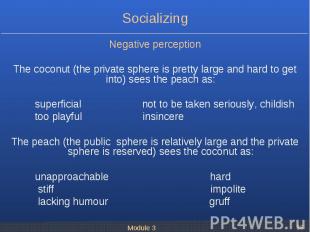
Negative perception Negative perception The coconut (the private sphere is pretty large and hard to get into) sees the peach as: superficial not to be taken seriously, childish too playful insincere The peach (the public sphere is relatively large and the private sphere is reserved) sees the coconut as: unapproachable hard stiff impolite lacking humour gruff

Positive perception Positive perception The coconut sees the peach as: open enthusiastic friendly humorous flexible The peach sees the coconut as: reliable proper clear honest trustworthy (adapted from Zaninelli 1994: 97-100)
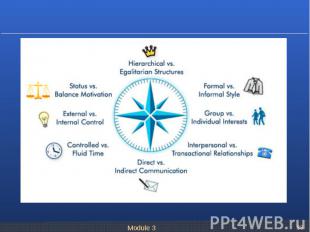

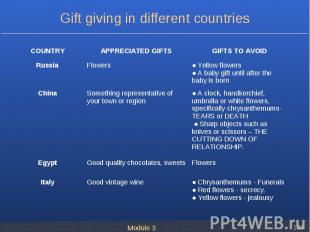






The defining characteristics of this dimension are: The defining characteristics of this dimension are: The relative importance of individual rights vs. the greater good of the group or society The source of an individual's identity and loyalties The value of individual contributions vs. teamwork in accomplishing and rewarding business goals The roles and responsibilities of individuals to other family members Appropriate levels of assertion and self-promotion within a society
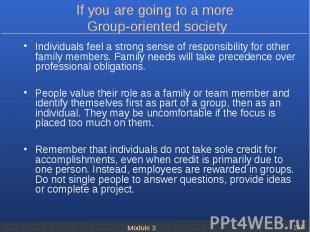
Individuals feel a strong sense of responsibility for other family members. Family needs will take precedence over professional obligations. Individuals feel a strong sense of responsibility for other family members. Family needs will take precedence over professional obligations. People value their role as a family or team member and identify themselves first as part of a group, then as an individual. They may be uncomfortable if the focus is placed too much on them. Remember that individuals do not take sole credit for accomplishments, even when credit is primarily due to one person. Instead, employees are rewarded in groups. Do not single people to answer questions, provide ideas or complete a project.

Promotions will draw heavily on seniority and experience - not performance and achievement. Decision making may be a slow process, as many individuals across the hierarchy will need to be consulted. However, once consensus is reached, implementation is usually quite rapid.

Don't expect to rely on the group to provide answers. An individual's importance and self-worth are determined by his or her ability to think and work independently. Don't expect to rely on the group to provide answers. An individual's importance and self-worth are determined by his or her ability to think and work independently. Try to be accepting of the fact that people live and work more independently. This may mean that they do not rely on building trusting relationships or networks of loyal contacts to fulfill their personal or professional roles and responsibilities. As an employer or manager, provide employees with sufficient opportunities for independent problem solving. Individuals will respond well to being given the autonomy, independence and flexibility to get the job done.

Be aware that it is culturally appropriate for employees to identify opportunities to demonstrate their abilities and "make their mark." In meetings and presentations, individuals will strive to distinguish themselves. Presentations tend to be dynamic and interactive. Be aware that it is culturally appropriate for employees to identify opportunities to demonstrate their abilities and "make their mark." In meetings and presentations, individuals will strive to distinguish themselves. Presentations tend to be dynamic and interactive. Remember that individual expression is encouraged and will be demonstrated in people's appearance, behavior and the way they decorate their homes and offices.
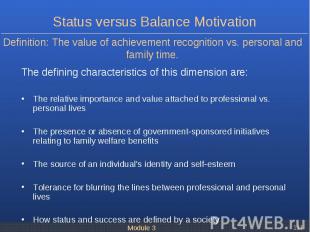
The defining characteristics of this dimension are: The defining characteristics of this dimension are: The relative importance and value attached to professional vs. personal lives The presence or absence of government-sponsored initiatives relating to family welfare benefits The source of an individual's identity and self-esteem Tolerance for blurring the lines between professional and personal lives How status and success are defined by a society

Recognize that to succeed in this environment, you will be expected to make sacrifices in the form of longer work hours, shorter vacation allowances and possibly frequent travel or moves. Recognize that to succeed in this environment, you will be expected to make sacrifices in the form of longer work hours, shorter vacation allowances and possibly frequent travel or moves. Be aware that people will discuss business anytime, anywhere with anyone. Recognize that people will use professional identity and achievements to evaluate others, and to provide a frame of reference for relating to others.

Whether in a new social or business situation, always be assertive and introduce yourself. Self-promotion is an acceptable part of the business culture in this competitive environment. Always carry business cards. Whether in a new social or business situation, always be assertive and introduce yourself. Self-promotion is an acceptable part of the business culture in this competitive environment. Always carry business cards. Expect people from different social backgrounds to work and socialize comfortably together. Rather than family background or connections, individuals will be evaluated - and define themselves—based on professional or personal accomplishments.

Recognize that employees will value their personal time, take longer vacation allowances, and will be reluctant to work late or on weekends. Recognize that employees will value their personal time, take longer vacation allowances, and will be reluctant to work late or on weekends. Small talk at business or social functions will cover every aspect of an individual's life and interests - and not focus exclusively on professional matters. Employees may have a strong work ethic and work hard, but they are more likely to work on a prescribed basis, not working beyond prescribed duties or hours. Recognize that attempts to network, to generate business leads, or to talk about work in general at social functions is considered inappropriate. Employees will be less willing to relocate for their jobs. Family obligations will take precedence over professional loyalties or advancement.

China -“The Morning Tea” Evening banquets China -“The Morning Tea” Evening banquets Yum Cha' tea drinking ritual Home entertaining India - Dinner at home Iran - Restaurant At functions Germany - Business Lunch Italy - Dining with a certain protocol Japan - Restaurant of your own culture “Karaoke” bars

































































































































